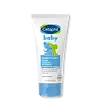What's inside
What's inside
 Key Ingredients
Key Ingredients

No key ingredients
 Benefits
Benefits

 Concerns
Concerns

No concerns
 Ingredients Side-by-side
Ingredients Side-by-side

Allantoin 0.5%
Skin ConditioningButyrospermum Parkii Oil
EmollientCalendula Officinalis Flower Extract
MaskingCaprylyl/Capryl Glucoside
CleansingCaprylyl Glycol
EmollientCitric Acid
BufferingGlycerin
HumectantGlycine Soja Oil
EmollientHelianthus Annuus Seed Oil
EmollientMethylpropanediol
SolventPanthenol
Skin ConditioningPantolactone
HumectantPhenoxyethanol
PreservativePolyisobutene
Sodium Acrylate/Sodium Acryloyldimethyl Taurate Copolymer
Emulsion StabilisingSorbitan Oleate
EmulsifyingTocopherol
AntioxidantWater
Skin ConditioningAllantoin 0.5%, Butyrospermum Parkii Oil, Calendula Officinalis Flower Extract, Caprylyl/Capryl Glucoside, Caprylyl Glycol, Citric Acid, Glycerin, Glycine Soja Oil, Helianthus Annuus Seed Oil, Methylpropanediol, Panthenol, Pantolactone, Phenoxyethanol, Polyisobutene, Sodium Acrylate/Sodium Acryloyldimethyl Taurate Copolymer, Sorbitan Oleate, Tocopherol, Water
Water
Skin ConditioningZinc Oxide
Cosmetic ColorantPetrolatum
EmollientCaprylic/Capric Triglyceride
MaskingDimethicone
EmollientGlycerin
HumectantMicrocrystalline Wax
Emulsion StabilisingPanthenol
Skin ConditioningHelianthus Annuus Seed Oil
EmollientMagnesium Sulfate
C18-38 Alkyl Hydroxystearoyl Stearate
EmollientPolyglyceryl-2 Oleate
EmulsifyingGlyceryl Stearate
EmollientPolyhydroxystearic Acid
EmulsifyingCaprylyl Glycol
EmollientPolyglyceryl-2 Stearate
EmulsifyingXanthan Gum
EmulsifyingEthylhexylglycerin
Skin ConditioningWater, Zinc Oxide, Petrolatum, Caprylic/Capric Triglyceride, Dimethicone, Glycerin, Microcrystalline Wax, Panthenol, Helianthus Annuus Seed Oil, Magnesium Sulfate, C18-38 Alkyl Hydroxystearoyl Stearate, Polyglyceryl-2 Oleate, Glyceryl Stearate, Polyhydroxystearic Acid, Caprylyl Glycol, Polyglyceryl-2 Stearate, Xanthan Gum, Ethylhexylglycerin
Ingredients Explained
These ingredients are found in both products.
Ingredients higher up in an ingredient list are typically present in a larger amount.
Caprylyl Glycol is a humectant and emollient, meaning it attracts and preserves moisture.
It is a common ingredient in many products, especially those designed to hydrate skin. The primary benefits are retaining moisture, skin softening, and promoting a healthy skin barrier.
Though Caprylyl Glycol is an alcohol derived from fatty acids, it is not the kind that can dry out skin.
This ingredient is also used as a preservative to extend the life of products. It has slight antimicrobial properties.
Learn more about Caprylyl GlycolGlycerin is already naturally found in your skin. It helps moisturize and protect your skin.
A study from 2016 found glycerin to be more effective as a humectant than AHAs and hyaluronic acid.
As a humectant, it helps the skin stay hydrated by pulling moisture to your skin. The low molecular weight of glycerin allows it to pull moisture into the deeper layers of your skin.
Hydrated skin improves your skin barrier; Your skin barrier helps protect against irritants and bacteria.
Glycerin has also been found to have antimicrobial and antiviral properties. Due to these properties, glycerin is often used in wound and burn treatments.
In cosmetics, glycerin is usually derived from plants such as soybean or palm. However, it can also be sourced from animals, such as tallow or animal fat.
This ingredient is organic, colorless, odorless, and non-toxic.
Glycerin is the name for this ingredient in American English. British English uses Glycerol/Glycerine.
Learn more about GlycerinHelianthus Annuus Seed Oil is the oil derived from the seeds of a Sunflower. Sunflower seed oil is non-fragrant. It is an emollient, meaning it helps to soften the skin.
Sunflower seed oil contains many fatty acids. The fatty acids found in sunflower seeds include (from highest amount to least): linoleic acid, myristic acid, palmitic acid, stearic acid, arachidic acid, oleic acid, and linolenic acid.
These fatty acids help the skin create ceramides. Ceramides play a role in repairing the skin barrier.
Helianthus Annuus Seed Oil helps moisturize the skin. This in turn helps the skin look more rejuvenated and smoother.
Sunflowers are rich in vitamin E.
Historians believe Indigenous cultures of North America domesticated sunflowers before corn. Thus they relied on sunflower oil for a variety of uses. One such use is moisturizing skin and hair.
Sunflower seed oil may not be fungal acne safe. We recommend speaking with a professional if you have any concerns.
Learn more about Helianthus Annuus Seed OilPanthenol is a common ingredient that helps hydrate and soothe the skin. It is found naturally in our skin and hair.
There are two forms of panthenol: D and L.
D-panthenol is also known as dexpanthenol. Most cosmetics use dexpanthenol or a mixture of D and L-panthenol.
Panthenol is famous due to its ability to go deeper into the skin's layers. Using this ingredient has numerous pros (and no cons):
Like hyaluronic acid, panthenol is a humectant. Humectants are able to bind and hold large amounts of water to keep skin hydrated.
This ingredient works well for wound healing. It works by increasing tissue in the wound and helps close open wounds.
Once oxidized, panthenol converts to pantothenic acid. Panthothenic acid is found in all living cells.
This ingredient is also referred to as pro-vitamin B5.
Learn more about PanthenolWater. It's the most common cosmetic ingredient of all. You'll usually see it at the top of ingredient lists, meaning that it makes up the largest part of the product.
So why is it so popular? Water most often acts as a solvent - this means that it helps dissolve other ingredients into the formulation.
You'll also recognize water as that liquid we all need to stay alive. If you see this, drink a glass of water. Stay hydrated!
Learn more about Water